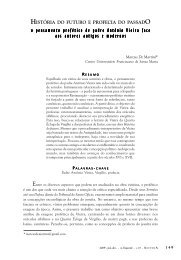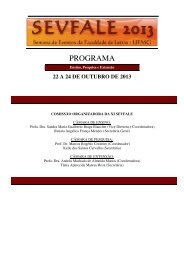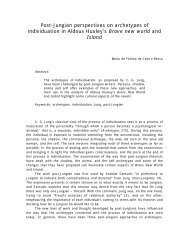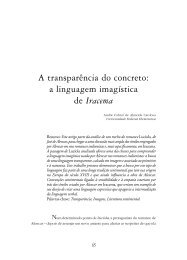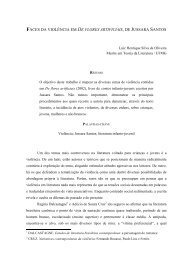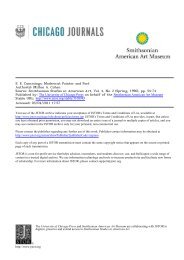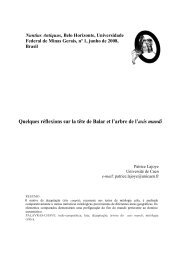Contornos do Indizível: o estilo de Clarice Lispector - Fale - UFMG
Contornos do Indizível: o estilo de Clarice Lispector - Fale - UFMG
Contornos do Indizível: o estilo de Clarice Lispector - Fale - UFMG
You also want an ePaper? Increase the reach of your titles
YUMPU automatically turns print PDFs into web optimized ePapers that Google loves.
Em Tese, Belo Horizonte, v. 10, p. 196-201, <strong>de</strong>z. 2006<br />
Beloved’s return wakes up all Sethe’s losses: the loss of her family, of her community<br />
life, and especially of her self-love. By trying to bury her past, Sethe loses the<br />
connection with her ancestors and with her collective i<strong>de</strong>ntity. She feels exiled and<br />
homeless in her own house and neighborhood.<br />
Therefore, Beloved represents a possibility of a reawakening of past experiences,<br />
and, through her voice, Morrison also creates an aesthetical and political engagement<br />
with the African American historical past. Beloved’s fragmented discourse is a powerful<br />
testimony of the past, which reflects not only her individual experience, but also<br />
recreates a connection with the world of her ancestors, which is represented by the<br />
suffering of slaves during The Middle Passage. Those aspects of her fragmented and<br />
disconnected discourse are also shown in the form of the text, with its blank spaces<br />
and disconnected sentences:<br />
“someone is trembling I can feel it over here he is fighting hard to leave his body which<br />
is a small bird trembling there is no room to tremble so he is not able to die The iron<br />
circle is around our neck I would bite the circle around her neck I know she <strong>do</strong>es not like<br />
it” (211). 3<br />
She represents all those unnamed, <strong>de</strong>-bodied and unvoiced slaves who died<br />
during The Middle Passage. In fragmented passages of the novel, the use of the<br />
personal pronoun “we” reinforces Beloved’s voice as a representation of the collective<br />
voice and memory of mur<strong>de</strong>red slaves who were thrown into the water: “they are not<br />
crouching now we are they are floating on the water” (212).<br />
Concerning Beloved’s role as an instrument of healing for her mother, it can be<br />
noticed, throughout the novel, how she induces Sethe to talk about her traumatic<br />
experiences from the past. Thus, the rea<strong>de</strong>rs become aware of Sethe’s childhood as a<br />
slave, the lynching of her mother, the sufferings in Sweet Home and her escape from<br />
there, the dismembering of her family, among other painful remembrances. Her<br />
rememories are painful and hurt her, but they are, at the same time, necessary to her<br />
process of healing. Sethe’s past haunts her, but she becomes aware that it is<br />
impossible just to continue hiding, forgetting, or even avoiding it, because it is<br />
somehow “waiting for” (35) her. Later she is able to un<strong>de</strong>rstand that her past is<br />
connected with her present as she says: “Some things go. Pass on. Some things just<br />
stay. Some things you forget. Other things you never <strong>do</strong> … Places, places are still there<br />
… Nothing ever dies … it is still there, waiting for you” (36). After recognizing the<br />
remarkable connection between her past and her frail present, Sethe involuntarily<br />
initiates a series of actions of healing and her fragmented rememory seems to<br />
unconsciously enable her to transform and restore her present by questioning herself<br />
about what was valuable or not. By rememorizing her past, Sethe realized how slavery<br />
did not allow her to have her mother’s presence, and she found out how she still lacked<br />
her mother’s love and companionship. She also remembered how she was scared of<br />
not recognizing her own mother, because they were not allowed to talk to each other<br />
or even to see each other.<br />
Through Sethe’s process of retelling her past stories, her displaced and<br />
fragmented i<strong>de</strong>ntity and self could be re-membered and re-signified. She also may be<br />
able to reconnect herself with her collective i<strong>de</strong>ntity that also nee<strong>de</strong>d to be restored.<br />
By bringing to the surface her traumas, she could rehabilitate herself and restart where<br />
the thread was cut — individually and collectively — that is, where the damage<br />
occurred. Her isolation from her community and her dislocated self were revealed in<br />
her fragmented and gapped narrative from her rememories of her traumatic past. In a<br />
turbulent way, she remembers her most hurtful experiences from the past: her<br />
Disponível em http://www.letras.ufmg.br/poslit<br />
199



